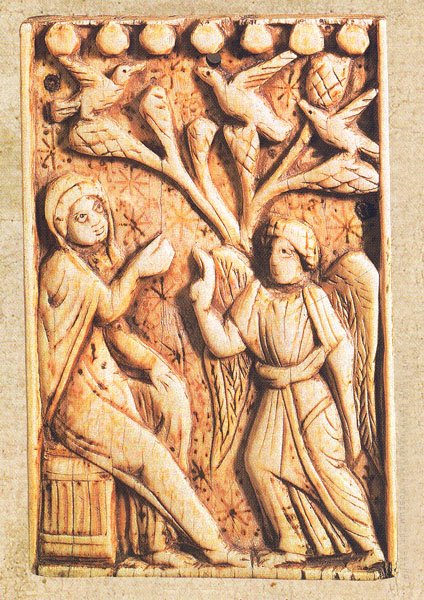Image Details

The State Heritage Museum, St. Petersburg
Mary’s mother and father. At about the time this ivory plaque was carved, Bishop Serenus of Marseilles determined that sacred pictures were bad for Christians because religious images were essentially a pagan idea. In 599–600 C.E., Pope Gregory the Great wrote Serenus a famous pair of cease-and-desist letters. Gregory said, in effect, that images were the best way for the unlettered to learn “the way.” Images were “the gospel on the walls.”
Until the invention of the printing press, the faithful heard the stories in sermons and liturgical readings, but it was the images surrounding them that stamped in their minds and hearts the reality of Jesus, Mary and Joseph. As a result, the church has passed on not only textual versions of the Christian faith’s founding stories but picture versions as well. And the latter may have had the greater influence on belief and practice.
The story of Mary has thus been handed down by the picture version of the apocryphal Infancy Gospel of James. The images are prolific: We have more than 85 different depictions derived from the gospel. All of the scenes shown with this article are impossible without the text version of the Gospel of James, which provides our earliest reference to Mary’s parents, Anna and Joachim. But the persistence of the stories must be credited to the “Gospel of James on the Walls.”
Our survey of this visual gospel begins with Mary’s mother, who is depicted in the ivory plaque, dating to about 600 C.E., now in the State Hermitage Museum in St. Petersburg. A heavenly messenger approaches Anna (seated at left) in her garden as she weeps and prays for a child. According to the Infancy Gospel of James, the angel informs Anna: “The Lord God has heard your prayer. You will conceive and give birth, and your child will be talked about all over the world” (James 4:2). The angel’s promise is fulfilled: Nine months later, Anna gives birth to Mary, mother of Jesus.
The birds in the trees on this plaque probably refer to the gospel’s previous chapter, in which Anna compares herself unfavorably to the birds: “Poor me! What am I like? I am not like the birds of the sky, because even the birds of the sky reproduce in your presence, O Lord” (James 3:3–4).
After receiving the joyous news from the angel, Anna “rushes out” of the city gate and “throws her arms around [Joachim’s] neck,” as she tells him that they will have a child. “Now I know that the Lord God has blessed me greatly,” Anna exclaims. “I, once childless, am now pregnant” (James 4:8, 9).
